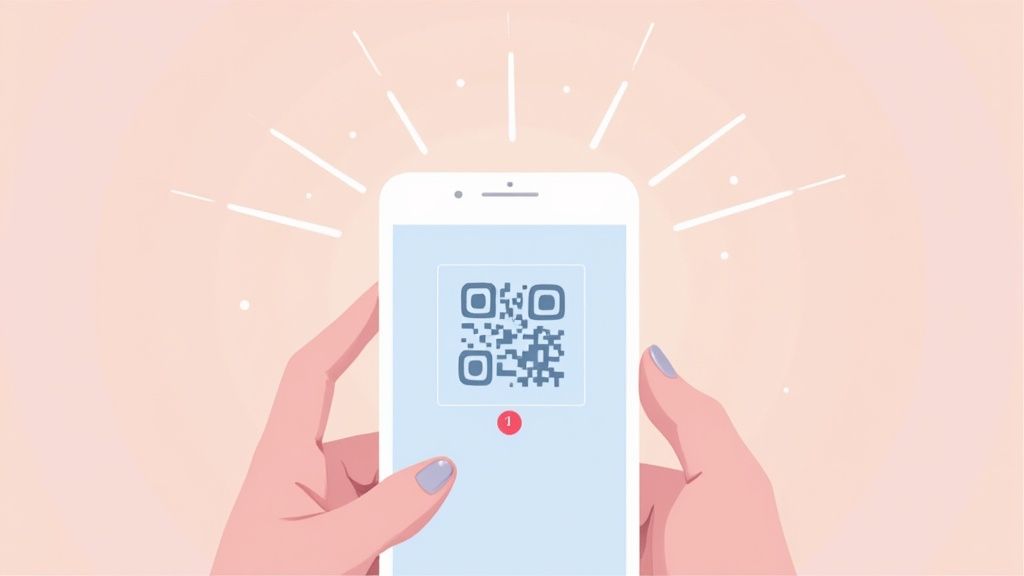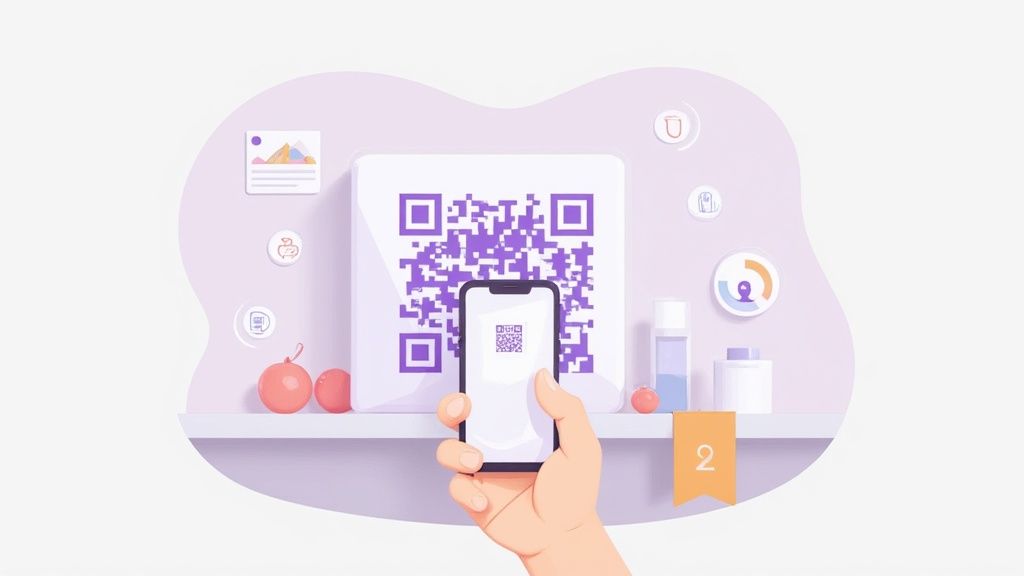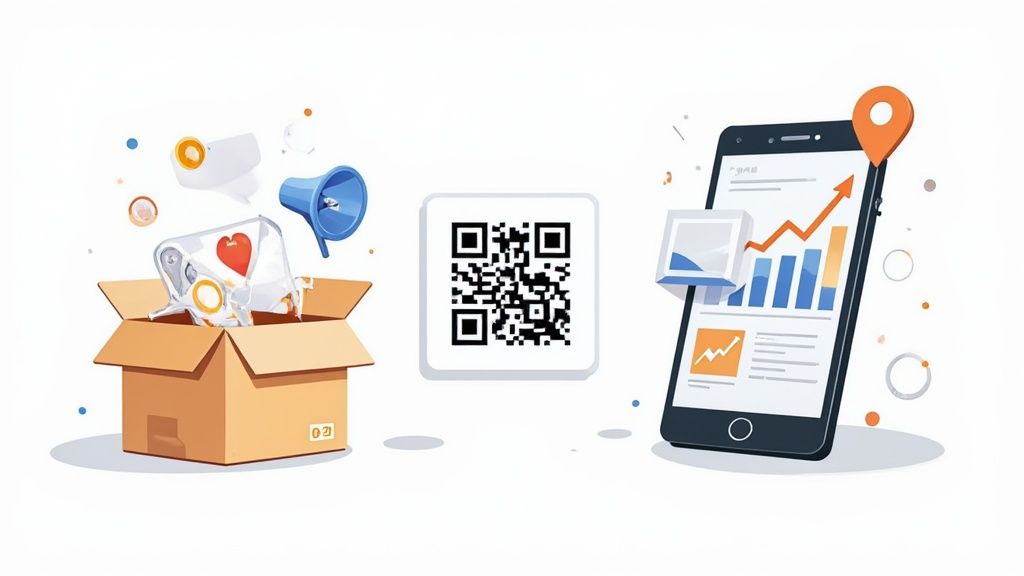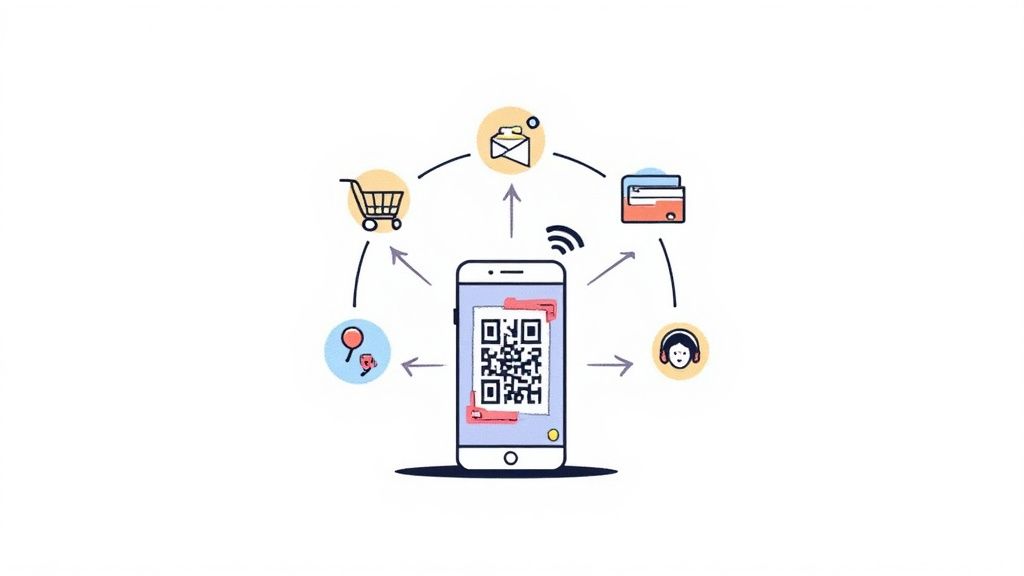You’ve definitely seen them everywhere—those quirky black-and-white squares on posters, packaging, and restaurant tables. But what do they actually do?
Think of a QR code as a super-fast shortcut. It’s a special kind of barcode your phone’s camera can read, instantly connecting you from a physical object to something online. No more fumbling to type in a long website address; just point, scan, and you’re there.
What Are QR Codes Really Used For?

At their heart, QR codes are all about instant access. They completely remove the hassle of getting from point A (seeing something in the real world) to point B (acting on it online). It’s the difference between seeing a cool product on a shelf and having all its reviews pop up on your screen a second later.
This simple function has opened up a world of possibilities. A quick scan can do so much:
- Instantly download an app you saw advertised on the subway.
- Pull up a restaurant’s full menu right from a small sticker on your table.
- Pay for parking without ever touching the meter.
- Watch a video tutorial for a product you’re holding in a store.
These codes are digital hand-raisers, saving everyone time and effort by making connections seamless. Their adaptability is their true superpower, making them a favorite for businesses trying to create a smoother, more engaging customer journey. To really dig into all the creative ways you can use them, take a look at the ultimate guide to using QR codes.
How QR Code Technology Actually Works
So, what’s really going on when you scan one of those little black and white squares? Let’s peek behind the curtain.
A QR code is just a fancy, two-dimensional barcode. Think about the standard barcode on your groceries—that single line of black bars holds a little bit of information. A QR code takes that concept and expands it into a grid, allowing it to store thousands of characters. It’s a huge leap in data capacity.
Think of it like a visual hyperlink. The unique pattern of squares is a language your phone’s camera understands instantly. It deciphers the pattern and turns it into something useful, like a website address, your contact info, or even the password to the local coffee shop’s Wi-Fi. That’s why a quick scan can send you straight to a webpage without any typing.
Static vs. Dynamic QR Codes
Here’s where things get interesting for businesses. Not all QR codes are the same, and knowing the difference is crucial.
Static QR Codes: This is the most basic type. All the information is locked directly into the QR code’s pattern. Once you create and print it, that’s it—you can’t change where it leads. They’re perfect for information that won’t ever change, like a link to your company’s main homepage.
Dynamic QR Codes: This is where the real power comes in. A dynamic QR code doesn’t hold the final destination link. Instead, it holds a short, middle-man URL that redirects the user to the final destination. The genius part? You can change that final destination anytime you want, without ever having to reprint the QR code. A restaurant, for example, could have one QR code on their tables that points to the lunch menu, then the dinner menu, and then a special holiday menu—all with a few clicks.
A dynamic QR code turns a simple printed square into a living, updatable marketing tool. This flexibility allows businesses to edit campaigns on the fly and track scan analytics, providing priceless insights into customer engagement.
Using QR Codes in Modern Marketing

If there’s one place QR codes have really found their home, it’s in marketing. They have completely changed the game by turning static, one-way ads into genuinely interactive experiences. A simple scan can turn a curious glance at a poster into a real, measurable action.
Picture this: someone is waiting for the bus and sees an ad for a new pair of sneakers. In the old days, they’d just look at it and move on. Now, they can scan a QR code and instantly watch a video of an athlete wearing the shoes, sign up for a contest, or even snag a limited-time discount. Just like that, a passive viewer becomes an active participant.
This is why you see QR codes everywhere now—on billboards, product packaging, and restaurant menus. They create a seamless bridge between the physical world and your digital content, making them a fantastic tool for generating new leads.
Measuring What Matters
For marketers, the real power isn’t just in the scan itself, but in what you learn from it. This is where dynamic QR codes come into play. They aren’t just a link; they’re a smart tool that gathers crucial data for you.
Tools like QR Star let you see exactly what’s happening with every scan. You can track how many people scanned your code, what time of day they did it, and a rough idea of their location. This kind of information is pure gold for figuring out if your physical marketing is actually working.
Suddenly, that print ad isn’t just a shot in the dark. It’s a measurable campaign with clear ROI. You can A/B test different designs or locations and see exactly what drives the most engagement.
This level of insight used to be impossible for offline campaigns. Now, you can finally know which flyers, posters, or product packages are catching people’s attention. You can find more inspiration by checking out these powerful QR code marketing examples.
Thanks to these simple squares, print advertising finally has the concrete data it needs to prove its worth.
QR Codes Are Changing How the World Pays
Beyond clever marketing tricks, one of the most powerful roles for QR codes is completely reshaping how we pay for things. They’ve become a key player in the global move toward payments that are fast, secure, and totally contactless. The whole process is refreshingly simple: you scan a code at the counter with your payment app, confirm the amount, and you’re done.
Forget fumbling for cards or cash. You don’t even need to tap a terminal anymore. This incredible ease of use is why QR code payments have exploded in popularity, especially for small businesses that can’t always afford traditional card readers. It really levels the playing field, giving any merchant with a smartphone the ability to accept digital payments.
A True Global Shift
The move to QR code payments isn’t just a passing fad; it’s a massive change in how people spend money all over the world. The technology quickly went from a quirky novelty to an everyday essential, especially as the demand for touch-free options soared.
This shift gets to the heart of what a QR code is for: it seamlessly connects our digital wallets to the physical world with incredible speed and ease.
The numbers behind this global surge are staggering. By 2025, it’s expected that more than 2 billion people will be paying with QR codes. That’s nearly 29% of all smartphone users on the planet. Diving into more QR code payment statistics really shows just how big this movement has become.
Everyday QR Code Uses You Might Not Know

We’ve all seen QR codes on restaurant menus and marketing flyers, but their real magic often happens in less obvious, everyday situations. They’ve quietly become the go-to tool for making life just a little bit easier, turning complicated tasks into a simple point-and-scan.
Think about sharing your home Wi-Fi password. It’s always a pain to read out a long string of random letters and numbers. Instead, a quick QR code lets your guests scan and connect instantly. No fuss, no typos, just seamless access.
Another brilliant use is the digital business card. Putting a vCard QR code on your physical card means a new contact can scan it and instantly save your name, number, email, and website right to their phone. It’s a modern twist that makes networking so much smoother.
More Practical Day-to-Day Uses
The versatility of QR codes is truly impressive, popping up everywhere from museums to airports to streamline our experiences. These little black-and-white squares can handle a surprising number of jobs.
- Museum Audio Guides: Scan a code next to an exhibit, and you can listen to an audio guide or watch a video about it right on your phone.
- Direct App Downloads: Spotted an ad for a cool new app? A quick scan takes you straight to the App Store or Google Play to download it.
- Event Information: At a concert or conference, scanning your ticket might pull up a full schedule, a map of the venue, or info about the performers.
- Boarding Passes: Most airlines now use QR codes for mobile boarding passes, which makes getting through the airport a whole lot faster.
The real beauty of a QR code is its ability to bridge the physical and digital worlds instantly. It gives you what you need, right when you need it, cutting out the small, frustrating steps in between.
From personal shortcuts to accessing public information, these codes are all about making connections simpler. If you’re curious to see just how creative you can get, check out our guide on 12 surprising ways to use QR codes.
Alright, let’s get down to actually making one of these things. Now that you’ve seen what QR codes can do, you’re probably wondering how to create one that really works for you.
You could just hop onto a free generator, and for a simple, one-off link, that might be fine. But if you’re using QR codes for anything serious—like a business, an event, or a marketing campaign—you’ll quickly hit a wall. To get the good stuff, you need a professional platform.
Think of a service like QR Star as your command center. This is where you create dynamic QR codes, which are a total game-changer. It means you can change where the code sends people at any time, without having to print a new one. Launch a new menu? Update the link. Made a typo in the URL? Fix it in seconds. This flexibility is priceless.
Plus, you can make them look like they belong to you. Slap your logo in the middle, change the colors to match your brand—suddenly it’s not just a random black-and-white box. It’s a recognizable and trustworthy part of your marketing.
A professional QR code platform takes a simple static link and turns it into a living, breathing marketing tool—one that’s flexible, trackable, and branded to deliver real results.
But here’s the most critical part: the data. A professional tool shows you exactly what’s happening with every single scan. You get analytics telling you when and where people are scanning your code. This is how you figure out what’s actually connecting with your audience and prove that your efforts are paying off. Making a QR code that does all this is surprisingly easy, and it’s the key to running a campaign that works.
Got Questions About QR Codes? We’ve Got Answers.
As QR codes pop up everywhere from restaurant menus to bus stop ads, it’s natural to have a few questions. Let’s clear up some of the most common ones.
A big one is always about security. Is it safe to scan any QR code you see? The short answer is: be smart about it. A QR code is just a container for information, usually a web link. The code itself is harmless, but just like clicking a link in a random email, the destination could be shady. Always pause and check the URL preview before you proceed, especially if you’re about to enter personal info.
Do QR Codes Ever Expire?
This is a great question, and the answer really depends on what kind of QR code you’re dealing with.
- Static QR codes are the “set it and forget it” type. The data is hardcoded right into the black-and-white pattern. As long as the website it points to is still online, that QR code will work forever.
- Dynamic QR codes, which are the specialty of QR Star, are different. The code itself doesn’t expire, but you have full control over the link it directs to. You can update, change, or even deactivate the destination anytime you want.
And they’re not just a fad. In the U.S. alone, around 89 million people scanned a QR code in 2022. That number is expected to jump past 100 million by 2025. If you’re curious, you can dig into even more QR code usage statistics to see just how widespread they’ve become.
Think of a QR code like a signpost. It’s just pointing the way. Your job is to make sure you trust the destination before you follow it. When you do, they are an incredibly handy tool.
Ready to create dynamic QR codes that you can track, customize, and update on the fly? See how simple it is to bridge your physical and digital worlds. Get started with QR Star today by visiting us at https://qrstar.com.
